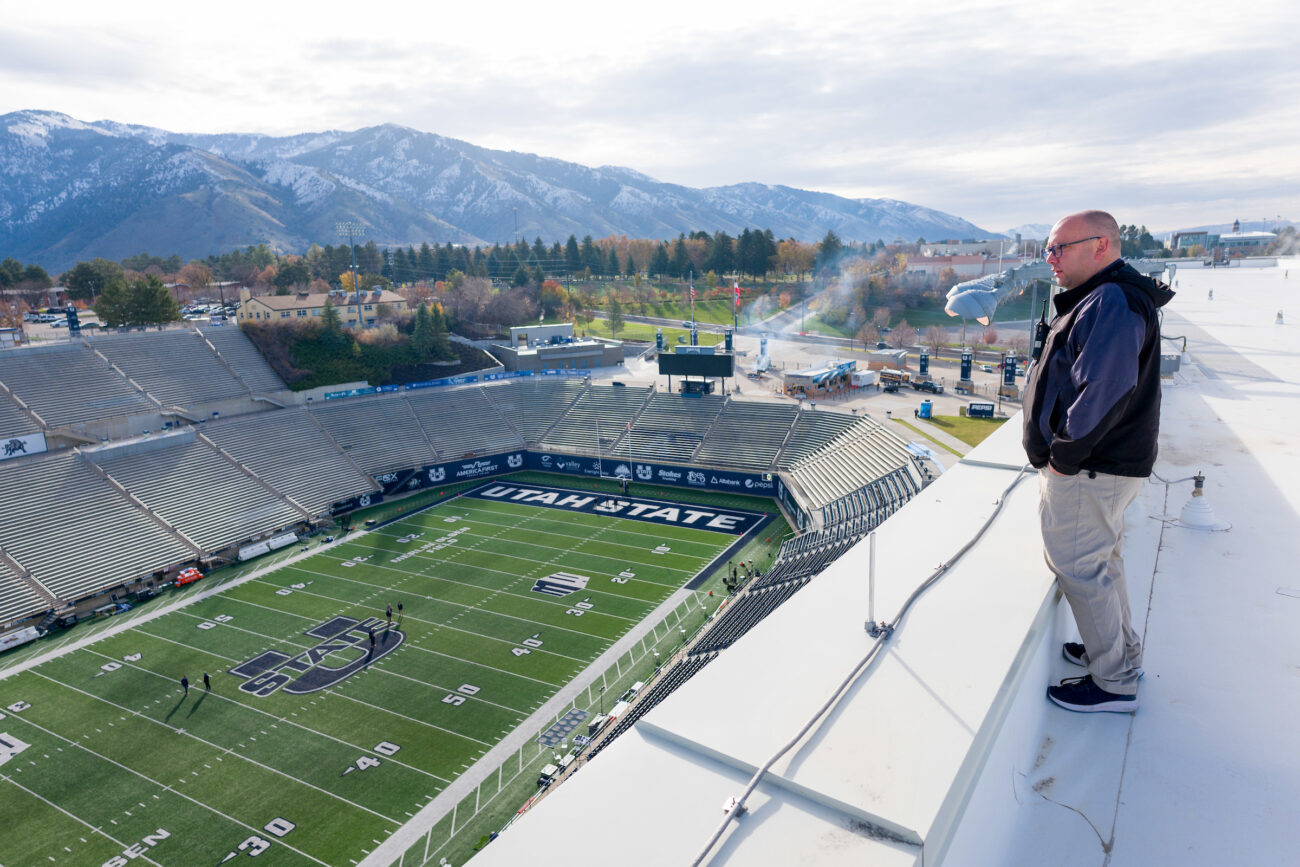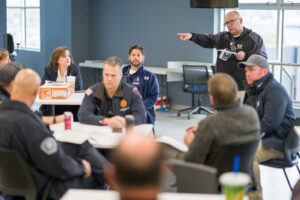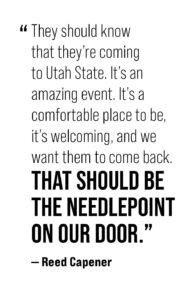‘How the Soup is Made’: Behind the Scenes With Event Services

Handling more than 1,000 annual events is no easy task, but USU’s Event Services team has created a one-stop-shop
By Timothy R. Olsen ’09, ’18
It’s 6 a.m. on Saturday, Oct. 7, the start of a beautiful fall morning in Cache Valley, though the sun is still 90 minutes from rising over the Bear River Mountain Range.
Despite the early hour, Brandon Hansen, Utah State University’s associate director for Events & Guest Services, is already in his office. It is the only office located in Maverik Stadium’s West Stadium Complex and offers a panoramic view of the still-sleeping valley.
Twelve hours from now, the Aggie football team will host Colorado State for the university’s annual Homecoming game, but Hansen and his team are getting an early start to make sure the day’s events run smoothly. It’s a process he’s been a part of now for 13 years.
“Brandon has the most varied view. We talked about a 30,000-foot view, he does that. But he also descends from 100,000 feet at 6 a.m., before anyone else gets to see it, because that’s who he is,” says Reed Capener, USU’s event services director. “He holds his groups to a high standard, and he expects that of the service providers that he engages as well. He’s first in, last out almost every time.”
Hansen estimates there are more than 2,700 employee hours spent on a game-by-game basis, which includes several facilities groups, the events staff, public safety, parking, dining, and various other groups not including the athletic department staff. While most fans likely only notice parking attendants, ticket scanners, and concession workers, there is so much more that goes on behind the scenes.

For example, on Thursday evening, 48 hours before the game, the Event Services staff set out the parking barricades used to close down certain streets near the stadium and direct traffic. On Friday, 24 hours prior to kickoff, the stadium was locked down and swept by USU campus police and Zoomer their bomb dog. This will happen again Saturday morning. Power needs to be checked for whichever group is broadcasting the game, as well as for food trucks and concessions. Through it all, Hansen and his team oversee all of it to ensure things run as smoothly as possible.
“Whatever it is, we want to be able to provide these different, good experiences for everybody that’s coming. My job, more than anything, is to help make sure that those people’s jobs are made as easy as possible,” Hansen says. “If we have a concessionaire lose power because the vendor brought a different power source than what was mentioned, we work with them to get ahold of our electricians and have them come down and see what we can do to adjust. It really is moving these little, tiny chess pieces around to position ourselves for the most success possible.”
Breaking Down Silos
While football games certainly involve months of planning and hundreds of hours of manpower to put on, they are by no means the university’s largest event — that would be Commencement — or its only event. Audrey Kirkman, USU’s event management system program coordinator, says Event Services received more than 3,800 event requests in 2023. Of those, more than 1,100 were labeled as “complex,” which means they involved multi-departmental communication and needed the oversight of an event coordinator.
“Anyone that’s given us a stewardship to use their space, we try to make sure that we’re respecting that space and following the rules,” Kirkman says. “We just make sure that we are being the best stewards of what’s been given to us, because we don’t really own any spaces on campus … we just make sure everyone can talk and function together.”
To aid in that oversight, Kirkman says there are currently 56 different Microsoft Outlook calendars that feed into her Event Management System (EMS), with nine more set to be integrated over the next year. The creation of that EMS and the integration of the calendars into it have been significant developments since Capener took over as director in 2018.
To most looking from the outside, Utah State University is a single entity. Large and sometimes ungainly, sure, but at the end of the day, a single entity. In reality, though, that is not the case. In reality, USU is comprised of various colleges, departments, and units that haven’t always been the best at communicating with each other. Traditionally, these areas have been pretty siloed, which is something Event Services has worked to overcome.
All told, there are over 100 buildings spread across 40 acres, eight — soon to be nine — colleges, and roughly 250 different departments at USU’s Logan campus.
“That’s the entire reason we exist, is to simplify. Our goal, being from an outsider’s perspective, no one should ever have to know or feel the pain of working with different departments,” Capener says. “Everyone should know when they see the USU logo, we’re all USU. No one should ever have to know that Dining, Facilities, Maintenance, Parking, Event Services, and the Office of Events are different departments. They should know that they’re coming to Utah State. It’s an amazing event. It’s a comfortable place to be, it’s welcoming, and we want them to come back. That’s what should be the needle point on our door.”
A Paradigm Shift

Capener vividly remembers a meeting in March 2019 where he was sitting around the large conference table in Champ Hall inside of Old Main with what he calls, “a lot of decision-making brainpower in the room.” During the meeting he was asked where everyone was on campus at that moment. In response, Capener opened his computer and relayed that he could only give the location of any groups within the system.
“They said, ‘Well why wouldn’t everyone be in there?’” he remembers.
That question led to some great conversations, better understanding of the hurdles the Event Services team faced in scheduling, and, ultimately, administrative support that has facilitated change in that area. Where in the past, one department would track things in Excel while another used Google Sheets and another used a paper desktop calendar, that information is slowly but surely finding its way under one roof.
“There have been a lot of a lot of really good advantages coming from that. It’s probably one of the biggest paradigm shifts, as we’ve gone around campus and offered, again, not forced, but offered training into the EMS system,” Capener explains. “That’s been huge, because a lot more people are now putting that information into one system, which again is fantastic because it helps mitigate risk and it helps the event safety.
“It’s not a control factor, it’s information flow. So, the more information is in there, the better equipped we are to make decisions based on if there were an emergency situation — anything from an active shooter situation to another pandemic to an earthquake. Where is everybody? Right? And we have it for both academics and events.”

Regardless of whether the event is a football game with 25,000 fans, the Howl with 5,500 students and dozens of support staff, an academic conference for a couple hundred attendees, or a catered club meeting with 20 members, the USU Event Services team has worked hard to create a “one-stop-shop” to serve the campus and community.
Both Hansen and Capener showered praise on the incredible staffs they work with, noting none of what they do would be possible without their team’s support. From cleaning up the stadium after a game until 4 a.m., to scraping gum off the Fieldhouse floor after a dance, to tearing down a stage in the Taggart Student Center Ballroom just to set up the room for a dinner the following night, the behind-the-scenes work of the Event Services team is an asset to the university.
“You know, it’s nice to get recognition every once in a while. But the recognition truly is deserved by those who are making it happen — the different service providers — and it’s just fun to see it all come together. You know, you get to be a part of watching the soup be made, as it were,” Hansen says.
“And, it’s really what you have to find rewarding. The reward in that, for me, is seeing people happy and excited and then going home and talking about their wonderful experience and wanting to come back. That’s a successful event — them wanting to come back to Utah State, because we’re nothing without our fans, without our students, and without our staff. So, for me, getting people to keep coming back, that’s the win.”





